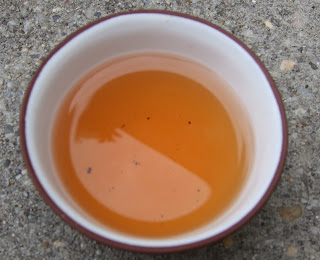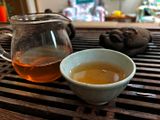Here it goes, my first tea review. I picked up this tea during my journeying through Taiwan, from my aunt's tea vendor friend. Even though since that time I've drank this tea multiple times, this is the first time that I'm reviewing it. I don't know how this tea was processed or how much (if any) roasting it underwent. The price is also a bit unclear, because as a friend of my aunt, the vendor gave me the "friend" price, which was around $30 for a good four ounces of tea.
Dry Leaves:

The dry leaves were greenish with golden hued stems. The tea leaves had a slight vegetal aroma, which from what background information I have on High Mountain Oolongs is a good indicator. The actual tea pellets were tightly kneaded, a good mark of its craftsmanship. The tea was clearly hand harvested, as shown through the "bud-leaves-stem" system as it unfurled.
Parameters: I brewed this tea using my yixing teapot, starting with a 10 second rinse, following with the 1st, 2nd, 3rd steepings for 25 seconds each. From the 4th steeping onward I increased the time by 10 seconds, until the final 8th brew. [added] I don't know exactly how much tea I used, but it covered about 1/3 of my yixing teapot. I'll be sure to give exact measurements as soon as my scale arrives
Tasting Notes:
The tea showed floral notes which peaked during the 2nd and 3rd steeping, which was followed with a slightly tart flavor that I can't really explain. The tea also started with strong fruity notes, which grew weaker by the 5th steeping onward. By the 6th steeping I noticed a slight vegetal aroma from the tea which I didn't notice before. By the 8th steeping the flavor was very faint, so I decided that was as much as the tea could take. Overall, I found that the tea was very tasty, with a mellowness coupled with slight astringency.

This was the second steeping of the tea; and although this poor photo cannot show it, the liquor has a golden color and incredible clarity.

Wet Leaves:
Upon closer inspection of the wet leaves I was able to get a sense of the handicraft that went though the processing of this particular tea. From feeling the leaves, it felt a bit thick and tearing a leaf took a little effort, showing that this truly is a high mountain tea. High Mountain Oolongs grow slower because the tea plantations are at such a high elevation. This lets the tea leaves accumulate more flavor because its growth is slower.
post note: I apologize if these photos are not up to par with the photos on other tea blogs. It's unfortunate that my dorm has poor lighting because my room is in an awkward position. But I feel that posting poor photos is better than no photos, because reading all text can be straining. So hopefully I'll be snapping better photos when I return home.
 Tasting Notes:
Tasting Notes: This was a good introduction to the Wuyi family of teas, and I'm looking forward to trying out the others. I think I'm going to order some Shuixian, Tie Lo Han, and Bai Ji Gui.
This was a good introduction to the Wuyi family of teas, and I'm looking forward to trying out the others. I think I'm going to order some Shuixian, Tie Lo Han, and Bai Ji Gui. This was a good introduction to the Wuyi family of teas, and I'm looking forward to trying out the others. I think I'm going to order some Shuixian, Tie Lo Han, and Bai Ji Gui.
This was a good introduction to the Wuyi family of teas, and I'm looking forward to trying out the others. I think I'm going to order some Shuixian, Tie Lo Han, and Bai Ji Gui.

























